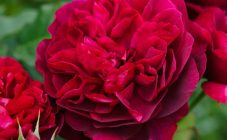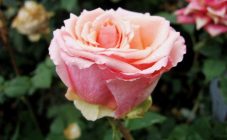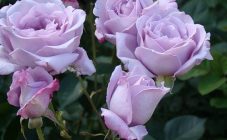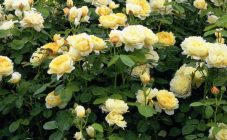Content:
A flower bed, on which flowers of extraordinary beauty bloom throughout the season, will be the best decoration for any garden area or park. A rose is deservedly considered one of the best in this regard, because its flowers are distinguished by grace and beautiful shapes, as well as a delicate aroma. Many breeders around the world are breeding new varieties of the "beauty queen", seeking to improve the resistance of this flowering perennial to winter cold, weather disasters, diseases and pest attacks. They also try to get varieties that would have a unique aroma and unusual colors of the petals of the buds. The English rose Falstaff is the result of the selection work of the specialist from Great Britain D. Austin. The main characteristics of the plant, the history of the appearance of this variety, the nuances of cultivation - these are the main topics that will be disclosed in this article.
Austin roses at a glance
In the middle of the last century, the English breeder D. Austin decided to reanimate old varieties of roses. These plants were quite beautiful, but had a low resistance to most diseases, including fungal and viral, invasion of harmful insects. Many varieties had low frost resistance, so they did not take root in those regions where the air temperature dropped below -10-15 ° С. Also, these flowering perennials grew poorly and bloomed in areas where the weather in summer was unpredictable: the heat was replaced by a period of rains, as a result, the plants suffered from drought, then from too much moisture in the soil and air, as a result, they were often affected by various types of rot.
To obtain new varieties, Austin crossed various types of roses, including from the polyanthus, climbing, floribunda varieties of the "queen of flowers", and also took old varieties. As a result, this breeder has more than 190 bred types, each of which is distinguished by the unique beauty of the buds, different sizes and shapes of fully blossoming flowers, and an enchanting aroma. New varieties of this perennial received positive qualities from their "parents", thanks to which, even decades after breeding, these roses do not lose popularity, therefore they are grown by flower growers in many countries of the world.
Greenhouse Falstaff rose was bred in 1999 and, according to experts, remains one of the most beautiful and unusual. It was obtained by crossing Floribunda, hybrid tea and vintage roses. As a result, the new flowering shrub took on many positive qualities from its "parents".
As a result, already 4 years after breeding, the new variety received a test certificate at the Adelaide competition held in Australia.
Description of the Falstaff rose
Austin's Rose Falstaff is like the perfect old rosebush, and the breeder has sought to achieve this when breeding new species. This hybrid has large, densely double buds that appear on erect, strong stems. The color of the velvet petals is dark crimson with a characteristic purple tint. The size of the flowers is at least 12-14 cm.
These perennial shrubs branch well, reaching 1.2-1.5 m in height. Falstaff rose 0.9-1.0 m in diameter. Shoots are dark green in color, well leafy, covered with a large number of thorns. The color of the foliage is bright emerald, its shape is oval, of medium size. The leaf plates are glossy, shiny.
These perennials are almost not susceptible to the following diseases:
- powdery mildew;
- black spot.
Aphids are not found on foliage. Saplings take root quickly, practically not freezing out in winter.
This rose blooms throughout the summer, the last buds can open in late August - early September. It should be remembered that inflorescences appear abundantly on the bushes at the beginning of the season, and re-flowering is less active.
Flowers are collected in several pieces (no more than 5), opening up, in a radius of 5-6 cm. A characteristic feature of these buds is that the petals are slightly curled inward. The outer ones at the beginning of flowering are darker, but as the flower opens, they begin to brighten.
Important! In park areas, the bushes of this variety look great both in single plantings and in composition with other roses, as well as with many perennials and annuals.
It is advisable to tie the shoots to supports at the beginning of the season, which will hold not only the stem itself, but also the inflorescences of densely double flowers.
Growing
The site on which these flowering perennials will grow should be prepared in the fall. During the digging, add cow dung or compost, and in the spring, after the soil has completely warmed up - complex mineral fertilizers for roses, which can be bought in specialized stores.
It is better to plant purchased seedlings in the spring (especially for beginner growers). In this case, young bushes during the summer period will have time to take root and gain strength before the upcoming cold weather. In the autumn, the time for planting should be selected so that the seedlings have time to take root before the onset of frost (about a month).
If they plan to grow this perennial shrub as a climbing variety, then it is better to plant it along the blank wall of the garden house, and you need to retreat from it at a distance of at least 0.7 m.
Planting Falstaff seedlings is carried out in the same way as other varieties of roses.
Further care for these bushes includes the following agrotechnical measures:
- regular watering as the soil dries up;
- loosening the soil with further mulching with peat or humus;
- weed removal;
- top dressing from the second season after planting;
- pruning bushes with the removal of dry, damaged weak shoots.
Advantages and disadvantages of the variety
Gardeners note the following undeniable benefits of the Falstaff rose:
- beautiful shape and bright color of blossoming buds;
- profuse flowering throughout the summer season;
- resistance to powdery mildew and black spot, practically not exposed to aphid invasion;
- good resistance to frost.
The variety has practically no disadvantages. Except that there are too many thorns on the shoots, and this makes it difficult to care for the bushes.To avoid scratching your hands, you should work with heavy work gloves during trimming.
Since its inception, this bush perennial has been recognized as one of the most beautiful among all Austin roses, so many growers of the world grow Falstaff in their plots, never ceasing to admire its flowering.
















